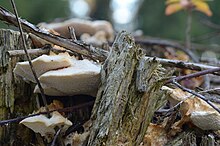Nordic porling
| Nordic porling | ||||||||||||
|---|---|---|---|---|---|---|---|---|---|---|---|---|

Nordic porling ( Climacocystis borealis ) |
||||||||||||
| Systematics | ||||||||||||
|
||||||||||||
| Scientific name of the genus | ||||||||||||
| Climacocystis | ||||||||||||
| Feces. & Pouzar | ||||||||||||
| Scientific name of the species | ||||||||||||
| Climacocystis borealis | ||||||||||||
| ( Fr. ) Kotl. & Pouzar |
The Nordic Porling or Northern Sponge Porling ( Climacocystis borealis , syn. Spongipellis borealis ) is a tree fungus from the monotypical genus Climacocystis . As a parasite, it causes simultaneous white rot in conifers. The short-lived fruiting bodies can be found in autumn on dying and dead tree trunks of spruce and fir trees, more rarely on deciduous trees.
features
Macroscopic features
The 5–15 cm wide, annual fruiting bodies are yellowish-white, 1–2 cm thick and have a sharp edge when fully grown. They often have a stem-like extension. The upper side is rough-felted to shaggy, on the underside there is the spore-forming fruit layer with 1–2 mm wide pores, some of which have uneven walls. When fresh, the fruit body is juicy and has an elastic, tough consistency. The flesh is yellowish-white and has radial fibers. When dry, you can see a two-layer trama (duplex trama) with a lower glassy, cartilaginous layer and a thinner upper layer that appears spongy and white-yellow.
Microscopic features
The broadly elliptical spores are 4–6.5 × 3–5 µm in size and are hyaline and inamyloid . The cystids are spindle-shaped and thick-walled. The hyphae have buckles and are purely generative , this is called a monomitic trama.
Ecology and diffusion
The Nordic Porling grows saprophytically mainly on spruce and also on firs , on dead trees and stumps. Less common hosts are European beech ( Fagus sylvatica ) and oak ( Quercus sp.). Observations from North America report infested maples ( Acer spp.) And poplars ( Populus spp.). The fungus causes white rot by breaking down the lignin in the wood. The species has a Holarctic distribution, it also occurs sporadically in southwest Australia and Venezuela . In Central Europe it occurs frequently in the Alps and in the low mountain ranges. It is very rare in northern Germany and Denmark. It is often massive on windbreak areas.
swell
literature
- German Josef Krieglsteiner (Ed.): The large mushrooms of Baden-Württemberg . Volume 1: General Part. Stand mushrooms: jelly, bark, prick and pore mushrooms. Ulmer, Stuttgart 2000, ISBN 3-8001-3528-0 .
Individual evidence
- ^ Synonyms of Climacocystis borealis . In: Species Fungorum . Retrieved December 8, 2012 .
- ↑ a b c d Hermann Jahn: The types of Porlinge I . In: Westphalian mushroom letters . tape 4 , no. 3 , 1963, p. 27-62 ( PDF; 2.41 MB ).
- ↑ a b c Svengunnar Ryman, Ingmar Holmåsen: Mushrooms . Bernhard Thalacker, Braunschweig 1992, ISBN 3-87815-043-1 .
Web links
- Climacocystis borealis in the Fungorum index
- No. 20: Climacocystis borealis - Northern sponge sponge . In: Aphyllophorales News. September 1, 2006, accessed on December 21, 2011 (Holzpilze - Porlinge - Barkpilze).
